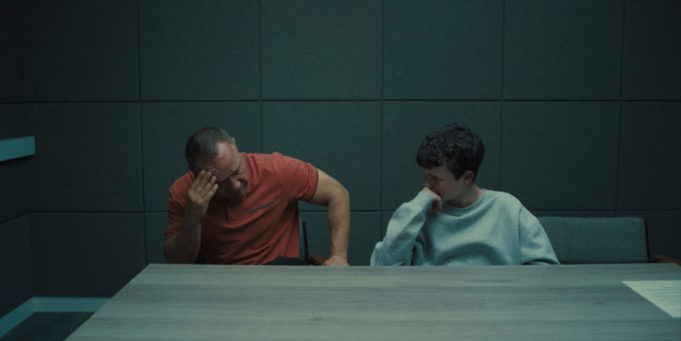Sometimes when a cultural phenomenon seems to come out of nowhere, I’m already on top of it. The British crime drama Adolescence quickly became a bigger hit on Netflix than even Bridgerton or Squid Game, and its roots were in a movie that I saw four years ago. Director Philip Barantini and star Stephen Graham collaborated on Boiling Point (which became another Netflix show) and shot the entire 92-minute film in a single take to convey a London restaurant chef’s downward spiral during an evening’s dinner service.
They’ve brought the same approach to Adolescence, all four episodes of which have been shot in one take. Working like this is a challenge for directors in terms of planning and logistics, and it’s fun for actors, who have an easier time following their characters’ arcs and get to harness live theater-like energy in a much larger environment. I’m not sure that this show needed the gimmick, but it is powerful television regardless.
The first episode begins with a police SWAT team smashing in the front door of Eddie Miller (Graham), a plumber in Doncaster, South Yorkshire, to arrest his 13-year-old son, Jamie (Owen Cooper), for murdering one of his classmates. The boy shouts, “I haven’t done anything” in a voice still unchanged by puberty. Jamie doesn’t fit the profile of a killer and seems terrified to be in a police station, but his public defender (Mark Stanley) warns Eddie that the police wouldn’t assemble a tactical team to arrest a minor unless they had compelling evidence. They do, and seeing CCTV footage of the murder leaves Eddie weeping beside his son and asking, “What have you done?”
My main issue with the film version of Boiling Point was that the filmmakers didn’t really have a story. This series (which was created by Graham and Jack Thorne, with Barantini directing all the episodes) is stronger on that point, as Jamie’s family, friends, and teachers as well as social workers and cops cast about for reasons why. Turns out the kid and his friends have been watching Andrew Tate’s videos, and if you don’t know who that is, consider yourself lucky. Yet the show refuses to give us pat answers, and so we see the lead homicide detective (Ashley Walters) taking advice on decoding Instagram comments from his son (Amari Bacchus), who’s a classmate of both Jamie and the victim. Episode 3 largely takes place in one room at the juvenile facility where Jamie is being held and where a child psychologist (Erin Doherty) interrogates him and triggers the boy’s violent side.
That’s where the show’s one-shot strategy is effectively discomfiting, as you’re trapped in a room with this emotionally troubled kid for longer than you’d like to be. It also spotlights the performance by Cooper, who has no other film or TV credits to his name and effortlessly captures the self-confidence that can be undone by a girl turning him down for a date. Recalling that old TV show Homicide: Life on the Street, I still think this could have been filmed in a conventional way without losing too much power. The one time the tactic really shines is at the end of Episode 2, when the camera is mounted on a drone and flies over the city of Doncaster from the school where the police are questioning kids to a parking lot several blocks away, where Eddie is laying flowers at the impromptu shrine where the murder happened. It’s a great shot (underscored by a children’s choir singing a cover of Sting’s “Fragile”), and it couldn’t have been done another way.
The show’s creators have emphasized the element of class in this story, and, yeah, it’s quite a sturdy thread to follow. Jamie’s parents are too busy working to pay much attention to him, and his school is underfunded and staffed by only a few teachers who actually give a damn. This environment doesn’t just victimize him. The dead girl’s best friend (Fatima Bojang) has zero faith in the ability of the adults around her to address the situation, and so she calls the police a bunch of useless idiots to their faces, then jumps Jamie’s best friend (Kaine Davis) and beats him until the teachers pull her away.
Inevitably, I take away something different. Right now, my hometown of Phoenix is talking about Preston Lord, a 16-year-old who went to a Halloween party in 2023, got into a verbal altercation, and was stomped on by a group of similarly aged boys until his body was unrecognizable. The parallels between that case and the show’s are not exact, but it seems to me like both the real-life killing and the fictional one could have just as easily happened in 1983 or 1943. This culture of macho crap that we’re all drowning in goes back decades, and it tells us that what makes a man a man is his ability to inflict pain and suffering on other people. That reverence for cruelty comes all the way down from the rapist in the White House to the manosphere to more than a few of the movies I see each month. Maybe some of this cult of violence is hardwired into the human male — I’m certainly not immune to it — but Adolescence steps back and wonders if this is the best we can do. I’m afraid it might be.










